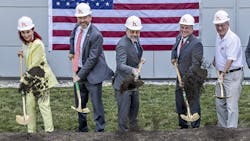Hikma’s planned $1B US investment comes at critical time for generic medicines supply
While generic medicines are the backbone of the drug market in the United States, making up approximately 90% of prescription volume, they represent a particularly vulnerable segment of the pharmaceutical supply chain. A recent analysis by U.S. Pharmacopeia (USP) found that generics come primarily from India, while the U.S. produces only 12% of the active pharmaceutical ingredients (API) for medicines going to patients in this country.
“Current generic drug payment policies and practices encourage purchasers to choose manufacturers largely based almost solely on lowest price,” Ronald Piervincenzi, CEO of USP, testified last month before the House Energy and Commerce Health Subcommittee.
John Murphy III, CEO of the Association for Accessible Medicines (AAM), told the House subcommittee that generic drug manufacturers have been driven to offshore API and other manufacturing as it is a “highly competitive, low margin industry in the U.S.” Over the last five years, the total dollar value of all generics sold in this country — including the availability of new medicines — has dropped by $6.5 billion, according to Murphy.
Although generics account for nearly 90% of the medicines relied on by Americans, Piervincenzi told lawmakers that the drugs represent less than 20% of the U.S. expenditure on medicines. In testimony last month before Congress, he also noted that contracts are “routinely” broken disincentivizing generic manufacturers to make capital expenditure investments.
“This can undermine initiatives to strengthen supply chain resilience by limiting the ability of manufacturers to invest in new, alternate manufacturing processes, domestic production, manufacturing updates and necessary facility maintenance, quality assurance and management, or to build redundancy into supply chains,” according to Piervincenzi.
Hikma’s $1B investment
Late last month, Hikma Pharmaceuticals USA announced a $1 billion investment to expand its U.S.-based manufacturing and R&D operations by 2030 to increase domestic production of generic medicines and boost the company’s capacity to address critical drug shortages across the country.
U.K.-headquartered Hikma has operated in the U.S. since 1991 and says it has spent more than $4 billion over the past 15 years to build, enhance and expand its U.S.-based R&D and manufacturing capabilities. Over that time, the company claims it “has provided patients with access to a wide range of generic medicines at a lower cost than branded products,” while maintaining an “excellent record” of FDA quality inspections and working with the regulatory agency to solve critical drug shortages.
In its latest phase of investment, dubbed America Leans on Hikma: Quality Medicines Manufactured in the USA, the company is looking to strengthen its portfolio of more than 800 medicines and increase its U.S.-based capacity to “produce large volumes of high-quality and affordable medicines for American hospitals, providers and patients.”
Specifically, Hikma plans to enhance and expand its sterile injectables production capabilities. The company claims to be a top three U.S. supplier of sterile injectable medicines, with more than 180 injectable products in its portfolio and a growing pipeline.
USP’s 2024 Annual Drug Shortages report, published in May 2025, found that of the 98 active drug shortages last year, 69% were sterile injectable drugs — which have higher manufacturing complexity.
Hikma’s $1 billion investment will be used to increase its production at sites in Cleveland and Columbus, Ohio, as well as Cherry Hill and Dayton, New Jersey. Currently, Hikma has annual domestic capacity to produce more than 12 billion finished doses of essential medicines, according to the company.
AAM, the Washington, D.C.-based trade group representing manufacturers and distributors of generic prescription drugs, commended Hikma for its investment in U.S. R&D and manufacturing, as it works with the Trump administration and Congress to “foster domestic manufacturing and a more resilient and reliable generic medicines supply.”
Rep. Buddy Carter (R-Ga.), chairman of House Energy and Commerce Health Subcommittee, in a statement said that Hikma and other generic manufacturers play a crucial role in “delivering affordable and accessible medicines to Americans,” while emphasizing the importance of onshoring the production of these critical drugs.
Looming tariff threat
As if the current business environment wasn’t challenging enough, generic drugmakers could potentially be hit with significant disruptions if pharma-specific tariffs are imposed by the Trump administration.
AAM has warned that U.S. tariffs on generics would increase the risk of drug and API shortages. Murphy said tariffs will “only amplify the problems that already exist in the U.S. market for affordable medicines.”
Marta Wosińska, a senior fellow at The Brookings Institution, made the case in a recent research article that while Trump’s tariffs could provide a strong incentive for increasing U.S. manufacturing of brand-name drugs, they will not for older, off-patent generic drugs.
“To manufacturers of generic drugs, incentives for onshoring production are significantly lower than for manufacturers of branded products,” Wosińska wrote, as the margin upside from locating in the U.S. will be limited. She also warned that tariffs could exacerbate drug shortages and discontinuations of generic sterile injectables with the adjustment of supply chains.
To onshore generic drug production, the Trump administration will need to deploy tools other than tariffs such as direct financing, according to Wosińska.
It’s a sentiment shared by Murphy, who in last month’s testimony before Congress called for “bold” U.S. industrial policy when it comes domestic manufacturing of generic drugs, such as the CHIPS Act — signed into law by President Biden in 2022 — which provided billions of dollars in subsidies to encourage companies to manufacture semiconductors domestically.
“This sort of industrial policy is the type of commitment that engages manufacturers, particularly those in lower-margin but high value production, to see the U.S. market as attractive for investment beyond just sales,” Murphy testified.
For now, however, the status quo of U.S. reliance on foreign manufacturing of pharmaceutical products and APIs continues due to what USP has called “race-to-the-bottom pricing dynamics” which pressure manufacturers to make drugs as inexpensively as possible — with low-price, older generics having a higher risk of drug shortage.
